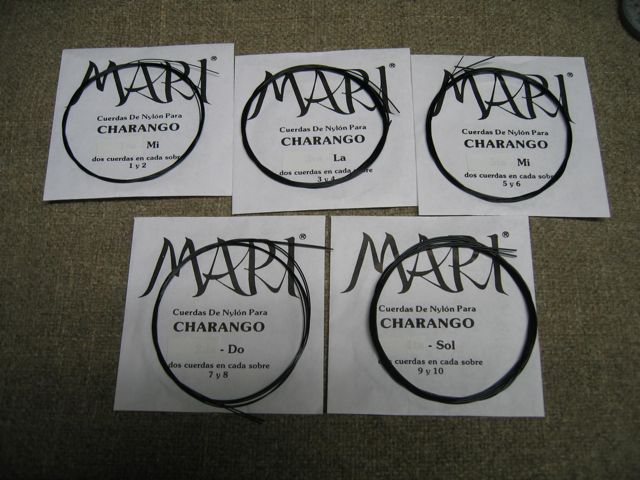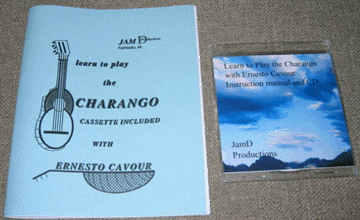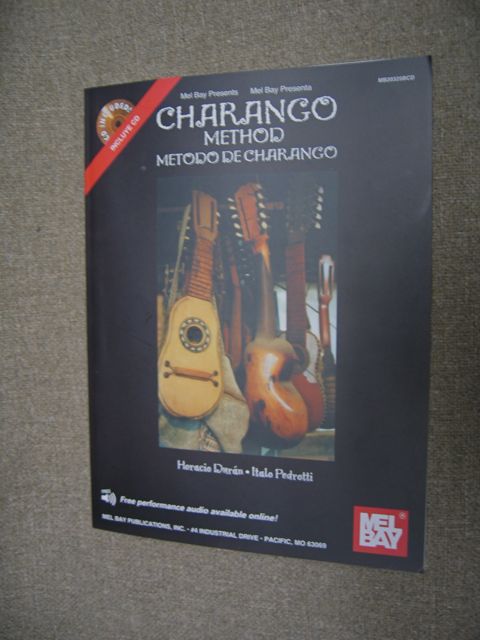

Charango: String Gauges, Tuning, Chord Booklet and Method Books
This page gives: 1) string gauges & tuning of the standard charango, 2) how charango tuning compares with guitar and ukulele tuning, and 3) chord booklet and method books for learning the charango.
Charango Strings Gauges and Tuning
The typical tuning for a standard charanago is gg, cc, eE, aa , ee , from the 10th to 1st (highest) string. These 10 strings are separated into pairs. The lowest note is the 5th string (E). For a guitar player it will seem curious that the lowest string is in the center of the strings. This type of tuning is call re-entrant tuning and it is typical of the Spanish vihuelas and guitars of the 16th and 17th century. Since the re-entrant tuning of the charango may be confusing in the beginning, I have decided to give the frequencies for each string. In the past, frequencies for each note were given in cycles per second, now it is common to call the frequencies Hertz which is abbreviated as Hz. Nowadays with good digital tuners, such as the iPhone Cleartone tuner, the note name and the Hz for the note are given. This is good because players (even experienced ones) sometimes have difficulty in tuning because they do not know what octave they have tuned the string to and consequently they break a lot of strings.
Typical string gauges for charangos with a 355mm to 385mm string length are:
0.016" for 1st, 2nd strings, tuned to E4= 659.26 Hz (known as Mi in Spanish)
0.026" for 3rd, 4th strings A4=440 Hz (known as La in Spanish)
0.030" for 5th string E3=329.63 Hz (known as Mi in Spanish)
0.016" for 6th string E4=659.26 Hz (known as Mi in Spanish)
0.020" for 7th, 8th strings C4=523.25 Hz (known as Do in Spanish)
0.030" for 9th, 10th strings G3=392Hz (known as Sol in Spanish)
In the information above with regard to the 1st and 2nd strings, "E4" means the pitch "E" in the 4th octave, which is defined as a frequency of 659.26 cycles per second (Hz)---this is the same note as the 1st string of the standard guitar at the 12th fret. The "A4" means "A" in the 4th octave which is defined as 440Hz--which is the internationally accepted pitch known as Concert A--it is the note at the 5th fret of the first string of the guitar. You will notice the octave difference between the E3 of the 5th string (329.63 Hz) and the E4 of the 6th string (659.26 Hz)--E3 is E in the 3rd ocatve and E4 is the E in the 4th octave. I am sure you already know that C4 (7th & 8th strings) is C in the 4th octave and G3 (9th & 10th strings) is G in the 3rd octave.
Most English speakers distinguish musical pitches as c d e f g a b c, while most Spanish speakers call these piches do re mi fa sol la si do. Therefore, in Spanish the tuning could be called sol sol, do do, mi mi, la la, mi mi.
The first 2 strings are called the first course, they are tuned in unison.
The second 2 strings are called the second course, they are tuned in unison.
The third 2 strings are called the third course, these are tuned an octave apart.
The fourth 2 strings are called the fourth course, they are tuned in unison.
The fifth 2 strings are called the fifth course, they are tuned in unison.
Thus, the tuning of the standard size charango (355mm to 385mm string length) is: e e, a a, E e, C C , g g
I suggest that you use a digital chromatic tuner to tune your charango.
I hope my precise description helps you understand charango tuning.
A few decades ago it was common to string charangos with various weights of nylon fishing line. Now good sounding strings which are accoustically superior are made in North and South America. From Argentina a good brand is Hispana in the US good charangos strings are made by Mari. I sell charango strings with the proper gauges in black nylon for $20 for 2 sets plus including shipping. See our email address at foot of page.


Black Nylon Charango Strings by Mari (USA) And Hispana (Argentina)
How charango tuning is like Ukulele and Guitar tuning
If you play guitar or ukulele, the chords on the charango will be easy to learn because the 2nd, 3rd, 4th and 5th (a, e, c, g) of the charango are tuned the same as the 1st, 2nd, 3rd and 4th strings of the standard ukulele (a, e, c, g) and the same as the first 4 strings of the guitar at the 5th fret (a, e, c, g). What this means is that if you understand the chord shapes (i.e., finger position of each string for each fret for each chord) for the guitar at the 5th fret or for the ukulele, all you have to do is figure out how to use the 1st string on the charge (which is tuned to "e"). Since the 3rd course (5th and 6th string) of the charango is also tuned to "e" and an octave below "e" , you can always play the same fret on the 1st course as you do on the 3rd course.
Here are the Charango chord and method books I use to have for sale:
Photo Below: Cavour, Ernesto, 2003, El ABC del Charango, Ediciones Tatu, 2003, La Paz Bolivia. This is a small very good chord book. It was put together by the great Ernesto Cavour. It presents the chords together in each key rather than as isolated chords. I use to sell this book but Ernesto Cavour now gives it away on his website for free. You can find this book (called metodo) and a 400-page book (libro) about the charango at: www.ernestocavour.com

----------------------------------------------------------------------------
Photo Below: Learn to Play the Charango from JAMD Production 1988, with CD, $30 with shipping in the US but $31.94 with shipping and tax if in California. This is an English translation of Ernesto Cavour's 1968 book Aprenda a Tocar Charango con Ernesto Cavour, Metodo Audiovisual, Ediciones Tatu, La Paz Bolivia. This is a straight forward booklet which will get you playing chords and a few songs very quickly. It is 42 pages long. It is very clear. The musical examples are written in tablature. It show the basic chords, the basic playing techniques and includes 6 traditional South American Charango pieces.This booklet made me feel confortable playing the charango. THIS BOO IS NO LONGER AVAILABLE (as of January 2015)

Photo of Learn to Play the Charango & CD
-------------------------------------------------------------------------------------
Photo below: Duran, Horacio y Italo Pedrotti, 2001, Metodo de Charango, Chile, Republished in 2010 in US as Charango Method by Mel Bay: This is a 208 page book with a CD. It is in English and Spanish. It is very well done--a beautiful book, $22.99 plus shipping and 8.75% if you are in California. The problem with this book is that it is probably TOO HARD for most players because it is written in standard music notation. There is no tablature. This is a great book for a good classical guitarist who can read music well, but for anyone else without a strong formal musical education, this book will be too difficult. I had great hopes for this book but I am very disappointed because it will not help most of the aspiring charango players. I read music well so I can handle this book but I have played for 45 years. Someone who is fascinated with the sound of the charango will be quickly bogged down with the formally written music in this book. This is a wonderful book for a graduate student in ethnomusicology.
This is a very extensive, complete and demanding course. It includes 201 exercises which start by training the student in the chords and rhythm pattern for various folkloric forms such as huanyno, bailecito, cachimbo, cueca (from Chile), and a folklore piece from Argentina. Next, the charango as a melodic instrument is explored--these exercises focus on major and minor scales, arpeggios and, for further practice, fragments of melodies from traditional charango pieces such as El Condor Pasa, Papel de Plata, Alturas, Rosita de Pica, Dos Palomitas, Vuelo de Parinas, Las obreras, Huajra, El humahuaqueño. Then, there are exercises explaining and showing the arpeggiated tremolo, ligado, trill, various other melodic ornamentations, the strummed tremelo (trémolo rasqueado), repique and a variety of strummed rhythm patterns.
The repertory section (in standard music notation only) has professional grade arrangements for a number of pieces including: Estudio para Charango by Mario Nuñez), Subida (Ernesto Cavour), Escarcha y Sol (Horacio Duran), Campanitas (Alfredo Dominguez), Mis Llamitas (Charango and guitar parts by Ernesto Cavour), Rositas de Pica (Hector Soto), Dos Esteban (Horacio Duran), Tonada Triste (Horacio Duran), Khespiña), Camino Viejo (Italo Pedrotti), Reencuentro (Claudio Araya), Manzanitas (Horacio Duran), Ventolera (Eduardo Carrasco & Hugo Lagos), Ojito de Agua (Adrian Otarola), Punteado (Ernesto Cavour), Cavuriadas (Italo Pedrotti), Volveras (Charango and Guitar partes by William Ernesto Centellas), Los Alaracos (Ernesto Cavour), De Ushuaia a La Quiaca (Gustavo Santaolalla), Otonal (Ital Pedrotti), Camino a Potosi (Freddy Torrealba), Vuelo de Pajaros ( Charango, Ronrroco and guitar by Italo Pedrotti). This is a good book for the very devoted willing to deal with standard music notation.

------------------------------------------------------------------------------
Nina, Eliodoro, 2000, Metodo de Charango, Tomo 1, Academia de Musica, Helios, La Paz, Bolivia. This book 96 page book is written in Spanish. It includes playing technique, chords, how to read music, origen of the charango. It has good arrangements by Professor Eliodoro Nina for solo charango (many with voice and words in Spanish) written in notation and tablature which includes Dos Palomitas, El Canto de las Ñustas, Naranjita, El Pedregoso, A Los Bosques, Potosino Soy, Tata Quillacas, Viva Mi Patria Bolivia, Moto Mendez, Quisiera un Puñal, Una Lagrima, Oh! Cochabamba, Cunumicita, El Llanto de Mi Madre, Oruro, Cholita Paceña, Lamentos, Bajo el Cielo de Potosi, Virgenes del Sol, El Charanguerito, Cueca del Negro, Battallon Segundo, Aires de Oropeza, Huellas de mi Llamita, Terciopelo Negro, Mis Llamitas, El Arriero. There are a few pieces in notation with written partes for Charango and Guitar such as Flor de Caña, Invitatcion de Amor. And there are a few pieces for solo charango written only in music notation: Ñucallacat, Rosa,Vals Venezolano and the very well known El Condor Pasa.
This book does not have a casette. The cost is $35 plus shipping.

Photo of cover of Metodo de Charango by Eliodoro Nina
Old Method Books for Charango
Since the mi-1990s, when I finally found a decent charango, I have searched for instructional material. I have found a number of method books but they are sometimes difficult to get because for they were printed in small quantities and are now out of print. The photo below shows a number of those method books printed in Argentina and Bolivia.

Here is a list of charango method books, some are out of print/or hard to find:
Bergonzi, Roberto, 1968 (originally published 1954) ,Metodo para Charango, Ricordi Americana, Buenos Aires
Camara, Alejando, 1997, Metodo Audiovisual de Charango, Belodromo, Cochabamba, Bolivia with cassette tape
Camara, Alejando, 1997, Acorde de Charango Escuela Musical "Camara", Cochabamba, Bolivia
Cavour, Ernesto, no date, Seleccion de Canciones para Charango , No. 1 y No 2
Cavour, Ernesto, 1968, revise 2005, Aprenda a Tocar Charango con Ernesto Cavour, Metodo, Audiovisual, Ediciones Tatu, La Paz Bolivia
Cavour, Ernesto, 2003, El ABC del Charango, Ediciones Tatu, 2003, La Paz Bolivia
Cavour, Ernesto, 2001, El Charngo: Su Vida, Costumbre y Desventuras. Producciones Cima, La Paz, Bolivia. 347 pages. This book in Spanish is the BEST book about the charango but it is not a method book.
Duran, Horacio y Italo Pedrotti, 2001, Metodo de Charango, Chile, republished 2010 in US as Charango Method by Mel Bay,
Gonzalez, Jorge, no date (ca 1990), Metodo de Charango, Partes1a, 2a, 3a, Guitarra Facil, Ediciones Libra, Mexico D.F.
Laura, Juan Jorge, 1985 (?)Apuntes para un Estudio del Charango,Producciones Pueblos del Sol, La Paz, Bolivia
Mar, Pedro, no date, Charango Course, Book One, (La Paz, Bolivia) with cassette tape
Navarro, Daniel y Patricio Sullivan, 2005, Los Secretos del Charango, Metodo didactico, Volume 1, Buenos Aires, Argentina
Nina, Eliodor, 2000, Metodo de Charango, Tomo 1, Academia de Musica, Helios, La Paz, Bolivia
I have provided the above list to show the reader that there are a number of people who have tried to share knowledge about the charango. With the internet and YouTube you can see a number of good players. One of my favorite players is Ernesto Cavour who has published a number a book and method about the charango and Andean instruments. There are also a number of YouTube videos showing how to play the repique and the tremolo.
Buena Suerte
If you are interested in any of these charango methods, contact me so I can tell you what I have in stock
Back to Charangos for Sale, Press here
Return to Fernandez Music Home Page
Ronald Fernandez, Fernandez Music, P.O. Box 5153, Irvine, California 92612, 949-856-1537